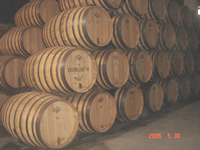 I am essentially a 7/14 person. I don't drink less than 7 % and more than 14% alcohol in my drinks. That rules out beer, whiskey vodka and a host of other liquids of pleasure. Essentially, because I do like some red wines with content of 14-14.5%, especially some Chilean and American Cabernets as also the higher alcohol Riojas which are generally beyond my 7/14 range but fortunately the alcohol is well integrated, adding to the structure of the wine.
I am essentially a 7/14 person. I don't drink less than 7 % and more than 14% alcohol in my drinks. That rules out beer, whiskey vodka and a host of other liquids of pleasure. Essentially, because I do like some red wines with content of 14-14.5%, especially some Chilean and American Cabernets as also the higher alcohol Riojas which are generally beyond my 7/14 range but fortunately the alcohol is well integrated, adding to the structure of the wine.
Sadly, this also rules out fortified wines like Sherry which can give a lot of pleasure. Nevertheless, it was an excellent learning experience visiting Vinoble Fortified and Dessert Wine Show last month in Jerez, the land of Sherry in Spain and learning about a really exciting product that this small region of Southwest Spain has been producing for over two millennia.
Sherry ( named by the British after Sherris- the Arabic name of the city of Jerez de la Frontera ) is a wine - fortified by adding neutral wine alcohol, to a min. level of 15%. Alcohol is added to the juice at some stage of fermentation(when alcohol is around 11%), thus increasing the alcohol content and stopping the natural fermentation.
It is made primarily from Palomino grapes though the sweeter grape Pedro Ximenez (PX) or Muscatel can also be used to blend or even on their own to make sweet or Cream sherry. Fermented on its own, Palomino makes a very insipid wine, low in acidity. But in this region a particular form of yeast named Saccharomyces exists on the surface of the wine. This yellowish material known as flor makes the wine oxidize slowly, giving the wine a tangy flavour. This is the first stage of sherry known as fino. In the neighbouring town of Sanlucar de Barrameda, the sea nearby gives a distinct salty flavour and the fino is known as Manzanilla.
 |
| Botas Of Aging Sherry-Solera At The Bottom, Criaderas On Top |
The wine is matured in neutral, old American casks known as botas or butts. All sherry is produced by fractional blending known as solera system. Newest sherry is kept on the top of barrels known as criaderas while the ready to bottle sherry is on the floor known as solera. Usually, one third of the liquid is poured into the row below, the bottom most barrel being emptied by a third into bottles, to make way for the liquid in the botas on top of it.
A typical fino, ready in the solera is five to ten years old. When the flor is non existent, wine tends to deteriorate fast and therefore fino should be drunk while young and preferably in one sitting. Since most sherries are non-vintage due to the solera system of aging and blending, one needs to depend on the reputation of the producer and importer to ensure a fresh product. Finos are too dry for most foreign customers who prefer sweeter sherries. They are mostly consumed within Spain and I would strongly recommend you taste them as aperitif on your next trip to Spain and with tapas.
To make the understanding of sherries even more complex, the finos can continue to age in the casks even when the flor dies out, first becoming fino-amontillado and then amontillado. Wines not designed as fino are fortified to around 18% killing the flor; these are called olorosos. other sherries are named as Palo Cortado, Pale Cream, Cream, each having different characteristics and sweetness levels and with slight amount of subjectivity involved along with the style of the winemaker..
Wines that have been aged for over 20 years are classified as V.O.S., (the English expression is ‘Very Old Sherry'). For wines more than 30 years old, the initials used are V.O.R.S., ‘Vinum Optimum Rare Signatum', also coinciding with the English expression ‘Very Old Rare Sherry'. Due to the tradition of its consumption in certain markets, these wines are also known as pale, dry, medium, brown, golden and rich.
Many of these terminologies are subjective and very confusing for the uninitiated. One needs to only enjoy the taste of these fortified wines with alcoholic content of 15-22% with a wide spectrum of aromas, flavour, body, sweetness and structure. It suffices to know that sherry can be stored for a few months in a cool place but when the bottle is opened it should be served chilled and finished within a week or so. Sometimes, it is acceptable to pour crushed ice in the sweet, Cream sherry.
The well known Harvey's Bristol Cream is a sweet Sherry crafted by blending Sherry made from the sweet Pedro Ximenez grapes and has been a popular brand in India. It is being produced by Domain Domecq owned by Pernaud Ricard, importers of Seagram whisky and Jacobs Creek wines in India. However, the brand Harvey's Bristol was sold a year ago to Jim Beam who are exporting it to India through their distributor Maxium.